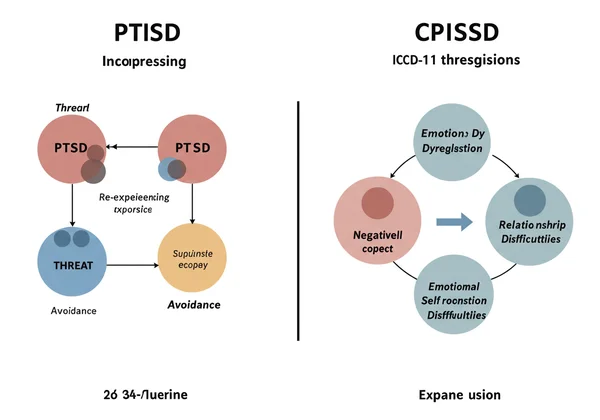Why the ITQ is Your Gold Standard CPTSD Test for ICD-11 Criteria
Have you ever wondered what makes a CPTSD test reliable? In a sea of online quizzes, finding a credible tool can feel overwhelming, especially when you're seeking clarity about deeply personal experiences. The key lies in scientific validation. This article demystifies the science behind effective CPTSD screening, focusing on the International Trauma Questionnaire (ITQ) and its direct alignment with the World Health Organization's (WHO) ICD-11 criteria. So, how can you truly trust a self-assessment? It all comes down to understanding the standards that make it reliable.

Understanding your experiences starts with asking the right questions. How can I tell if I have CPTSD? A scientifically-backed screening can provide preliminary insights and a framework for your journey. For a confidential and validated starting point, you can take our free test.
Understanding the ITQ: Your Online CPTSD Screening Test
When you encounter an online Complex PTSD test, it's essential to know what it's built upon. The International Trauma Questionnaire (ITQ) is widely recognized as the gold standard for measuring symptoms consistent with the WHO's International Classification of Diseases, 11th Revision (ICD-11). It was specifically designed to reflect the official diagnostic framework for both PTSD and Complex PTSD, making it an invaluable tool for both individuals and clinicians.
The ITQ isn't just another checklist; it's a carefully constructed questionnaire. It systematically evaluates the specific symptom clusters that define CPTSD, ensuring that the results provide a comprehensive and relevant snapshot of a person's recent experiences. This structure is what separates a meaningful screening from a generic online quiz. It provides a reliable foundation for self-reflection and can serve as an excellent starting point for a conversation with a mental health professional.
How the ITQ Measures Core CPTSD Symptoms
The ITQ truly shines in its precision. The questionnaire is divided into sections that directly correspond to the official diagnostic criteria. It assesses two main areas: the six core symptoms of PTSD and the three additional symptoms that define CPTSD, known as Disturbances in Self-Organization (DSO).

First, it asks about the classic PTSD symptoms, which are grouped into three clusters: Re-experiencing the trauma in the here and now (e.g., flashbacks or nightmares), Avoidance of traumatic reminders (e.g., avoiding people, places, or thoughts), and a persistent sense of current Threat (e.g., hypervigilance or an exaggerated startle response). Then, it delves into the DSO symptoms, which are unique to CPTSD and capture the pervasive impact of long-term trauma.
The ITQ's Role in Validating Your Experience
For many who have lived through prolonged or repeated trauma, one of the greatest struggles is self-doubt and confusion. You may wonder if your feelings are real, valid, or "bad enough." This is where a scientifically grounded tool like the ITQ becomes so powerful. By systematically asking about internationally recognized symptoms, it provides a mirror to your lived experience.
Seeing your struggles reflected in the questions of a validated mental health tool can be an incredibly validating moment. It shifts the narrative from "What's wrong with me?" to "I am experiencing symptoms that are a recognized response to trauma." This validation is not a diagnosis, but it is a critical step in reducing self-blame and empowering you to seek the right support. A good CPTSD screening can help you connect the dots.
The Foundation: ICD-11 CPTSD Criteria Explained
The ICD-11, published by the World Health Organization, is the global standard for diagnostic health information. Its official recognition of Complex PTSD as a distinct diagnosis was a monumental step forward for trauma survivors. Before this, many individuals with symptoms stemming from chronic trauma were often misdiagnosed, leaving them without a clear understanding of their condition.
The ICD-11 provides a clear and authoritative framework that helps distinguish CPTSD from other related conditions. This is not just medical jargon; it is the blueprint that informs effective screening tools and treatment approaches. By grounding its assessment in these criteria, a tool like the free CPTSD screening tool available here ensures its relevance and alignment with the latest clinical understanding.
Distinguishing CPTSD from PTSD in ICD-11
A common point of confusion is the difference between PTSD and CPTSD. The ICD-11 clarifies this beautifully. Both diagnoses require that a person has experienced a traumatic event and exhibits the three core PTSD symptom clusters mentioned earlier: Re-experiencing, Avoidance, and a Sense of Threat.
However, a CPTSD diagnosis requires the presence of those three clusters plus three additional clusters that fall under the umbrella of Disturbances in Self-Organization (DSO). These DSO symptoms reflect the profound, long-term impact of trauma on a person's sense of self and their ability to connect with others. This distinction is vital because it acknowledges that the effects of prolonged trauma, such as childhood abuse or domestic violence, are different and more pervasive than those from a single-incident trauma.

The Three Core Symptom Clusters of CPTSD
The ICD-11 defines CPTSD through its six interlocking symptom clusters. The first three are the core of PTSD:
- Re-experiencing: Unwanted and distressing memories, flashbacks, or nightmares.
- Avoidance: Actively avoiding internal reminders (thoughts, feelings) or external reminders (people, places) of the trauma.
- Sense of Threat: A persistent feeling of being on high alert or easily startled.
The next three are the DSO clusters that are specific to CPTSD, which we will explore in more detail below. Understanding this six-part structure is key to grasping what an effective ITQ test online is designed to measure.
Delving Deeper: Disturbances in Self-Organization (DSO)
Disturbances in Self-Organization (DSO) are the heart of what makes Complex PTSD unique. These symptoms arise from trauma that is often interpersonal and prolonged, deeply affecting a person's core identity, emotional regulation, and ability to form secure relationships. A reliable CPTSD self-assessment must accurately screen for these foundational challenges.
DSO captures the ways in which chronic trauma can fundamentally alter how you see yourself and the world. It’s not just about managing fear; it’s about navigating life with a wounded sense of self. Recognizing these patterns is often the first step toward targeted healing and self-compassion. To see how these symptoms might relate to you, you can start your self-assessment.
Emotional Dysregulation: A Key DSO Component
This is more than just moodiness. Emotional dysregulation in CPTSD involves intense, often overwhelming emotional reactions that feel difficult to manage. It can manifest as heightened emotional reactivity, violent outbursts, or reckless behavior.
Conversely, it can also present as emotional numbing or dissociation—a feeling of being detached from your emotions or your body. You might feel "flat" or unable to experience positive feelings. This emotional rollercoaster is a direct consequence of the nervous system's adaptation to a persistently unsafe environment.

Identity & Relationship Challenges in DSO
The other two pillars of DSO are deeply intertwined. The first is a negative self-concept, characterized by persistent beliefs of being diminished, defeated, or worthless. This is often accompanied by profound feelings of shame, guilt, or failure related to the trauma. It’s the harsh inner critic that constantly tells you that you are flawed.
The second is difficulties in relationships. This can manifest as a struggle to feel close to others, a persistent pattern of avoiding or withdrawing from relationships, or a feeling of being disconnected from the rest of humanity. Trust becomes incredibly difficult, making it hard to sustain the intimate connections that are vital for well-being. If this sounds familiar, a preliminary screening might offer some clarity.
Empowering Your Understanding with Reliable CPTSD Screening
Navigating the path of healing from trauma begins with understanding. By using a screening tool that is built on the scientific foundation of the ICD-11 criteria and meticulously designed like the International Trauma Questionnaire (ITQ), you are not just taking a quiz—you are engaging with a process that respects the complexity of your experience.
This knowledge can be incredibly empowering. It offers you a language to describe your experiences and a framework to understand your symptoms, not as personal failings, but as perfectly understandable responses to overwhelming circumstances. A credible, confidential screening is a powerful first step in reclaiming your narrative and moving toward healing.
Ready to gain a clearer perspective? Take the free, confidential, and scientifically-based CPTSD test on our homepage to receive your preliminary insights today. Your journey to understanding starts here: Take Your Free CPTSD Test.
Frequently Asked Questions About CPTSD Screening & Criteria
How can I tell if I have CPTSD?
Telling if you have CPTSD requires a comprehensive evaluation by a qualified mental health professional. However, a reliable first step is to use a scientifically-backed screening tool. Such tools, based on the ICD-11 criteria, can help you identify if you are experiencing the core symptom clusters, including re-experiencing, avoidance, sense of threat, and disturbances in self-organization. The results can provide a valuable starting point for a discussion with a therapist.
What are the main symptom clusters of CPTSD according to ICD-11?
According to the ICD-11, CPTSD includes the three core symptom clusters of PTSD (Re-experiencing, Avoidance, and Sense of Threat) plus three additional clusters known as Disturbances in Self-Organization (DSO). These DSO clusters are: 1) severe and pervasive problems in affect regulation; 2) persistent beliefs about oneself as diminished, defeated or worthless, accompanied by deep-seated feelings of shame or guilt; and 3) persistent difficulties in sustaining relationships and in feeling close to others.
Is CPTSD the same as Borderline Personality Disorder (BPD)?
While there can be an overlap in symptoms like emotional dysregulation and relationship difficulties, CPTSD and BPD are distinct conditions with different origins. CPTSD is fundamentally a trauma-related disorder rooted in a response to prolonged traumatic events. BPD is a personality disorder with a more complex etiology that may or may not include trauma. A thorough assessment by a professional is needed to differentiate between them, but a validated screening can help clarify trauma-related symptoms. For a closer look, you can explore the ITQ test.
What is the first step in seeking help for CPTSD?
The very first step is acknowledging your struggles and seeking understanding. Taking a confidential and scientifically-based CPTSD screening test can be an empowering way to validate your experiences and organize your thoughts. The next crucial step is to share these results with a trauma-informed therapist or doctor who can conduct a formal assessment and guide you toward appropriate therapeutic options, such as EMDR, somatic experiencing, or internal family systems (IFS) therapy.
Disclaimer: This article is for informational purposes only and does not constitute medical advice. The test on this website is a screening tool, not a diagnostic instrument. Please consult with a qualified mental health professional for an accurate diagnosis and treatment plan.